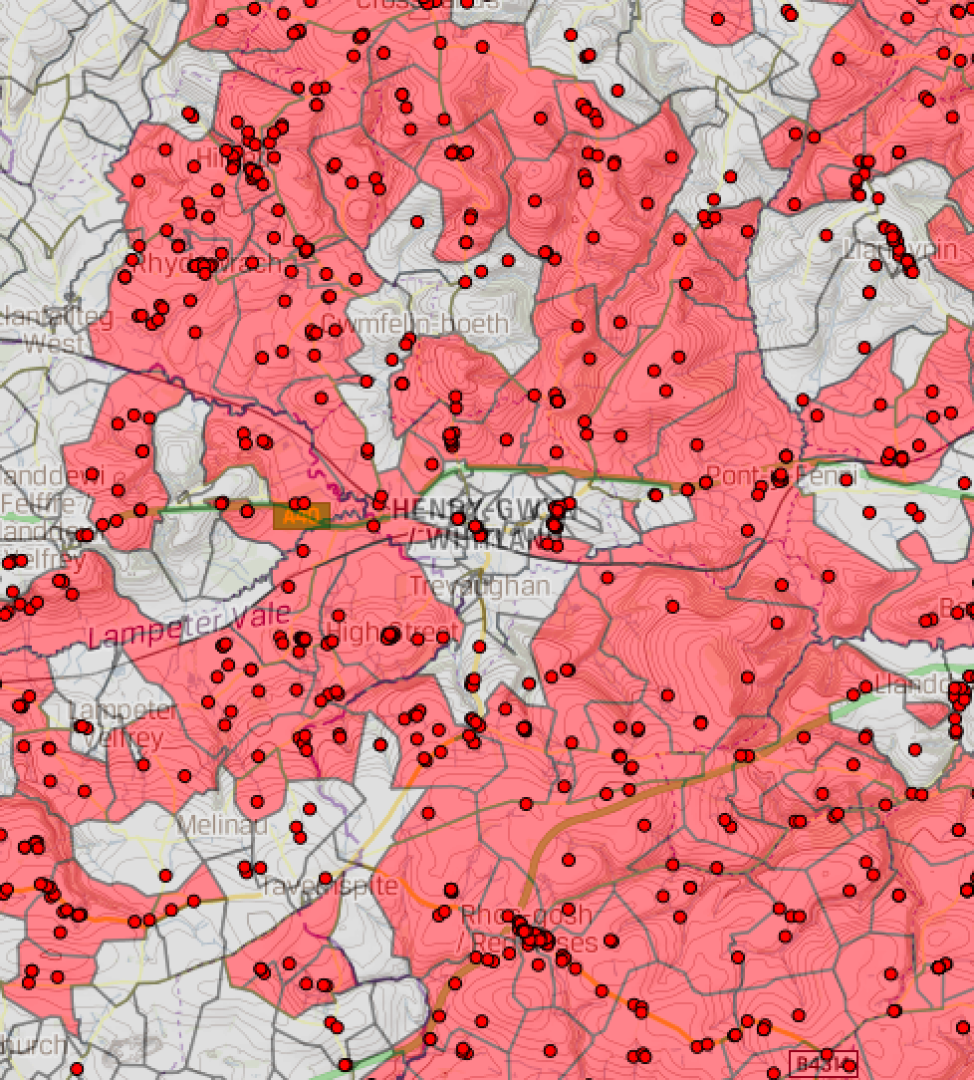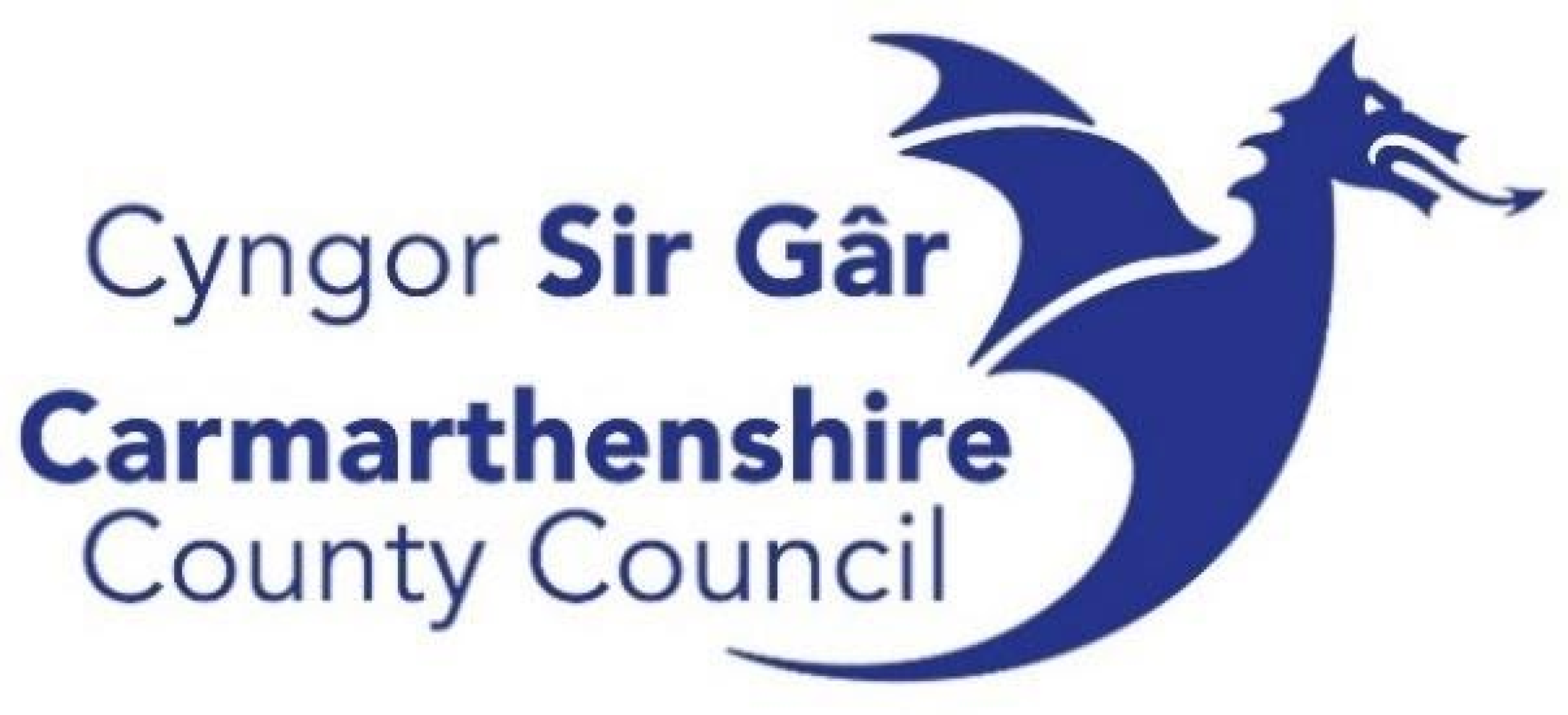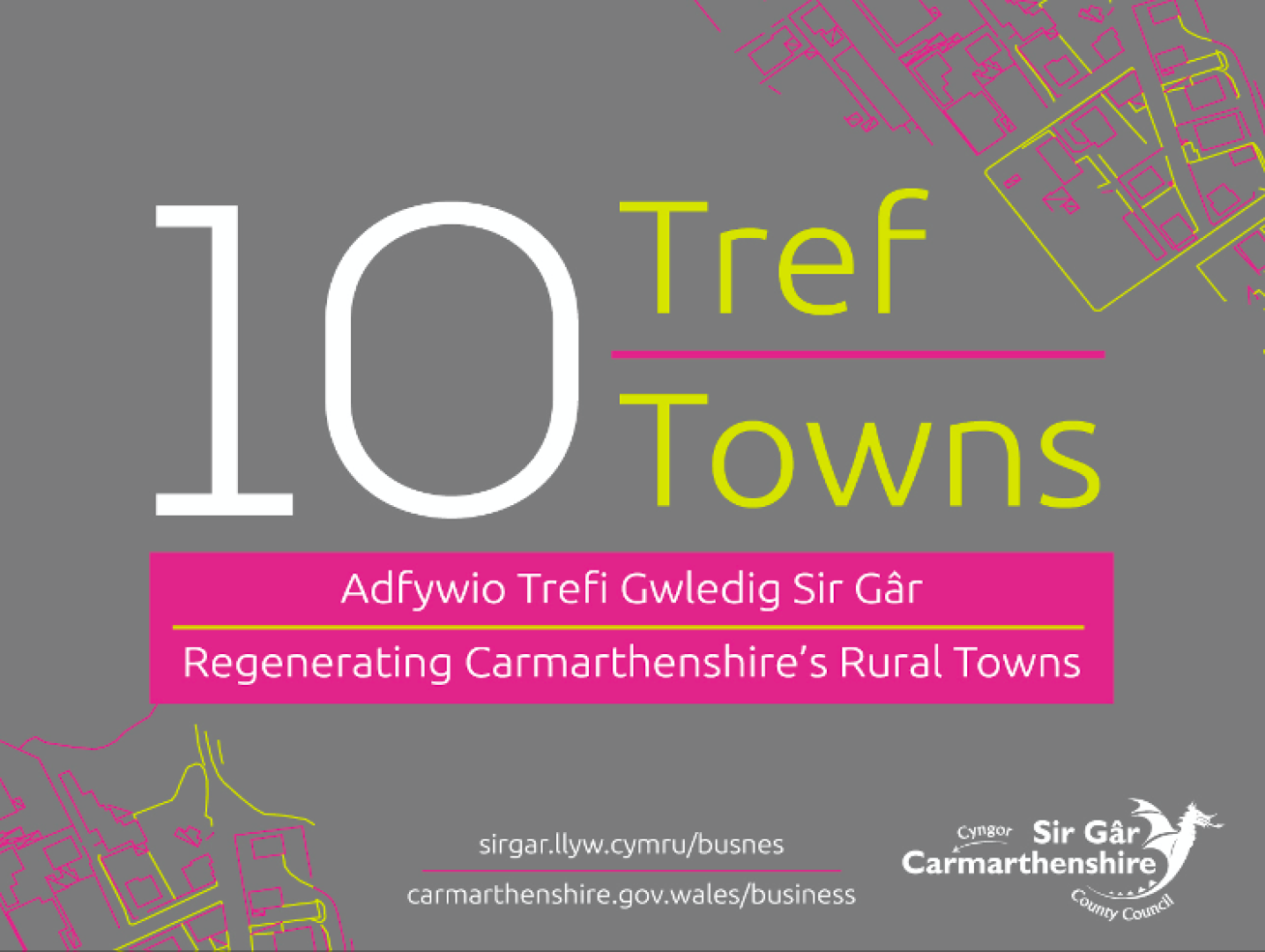About St. Whitland
The bigger picture
The context for the plan is shaped by wider social, economic and environmental issues facing rural Carmarthenshire including technology, climate emergency and decarbonisation, the ongoing impacts of COVID-19 and leaving the European Union (Brexit).
The strategic context also includes priorities of Carmarthenshire County Council, the Swansea Bay City Region and the Welsh Government, along with the growing influence of the Well-being of Future Generations (Wales) Act and local Well-being Plans.
A key aim of the Act calls on public bodies to be more agile to ensure they are able to respond to ever-changing economic circumstances and to maximise new opportunities for growth. Sustainable development is applied throughout, as well as new ways of working ensuring that local authorities take account of the long term, prevent problems occurring or getting worse, and adopt an integrated and collaborative people-focused approach.
The context for the plan is shaped by wider social, economic and environmental issues facing rural Carmarthenshire including technology, climate emergency and decarbonisation, the ongoing impacts of COVID-19 and leaving the European Union (Brexit).
The strategic context also includes priorities of Carmarthenshire County Council, the Swansea Bay City Region and the Welsh Government, along with the growing influence of the Well-being of Future Generations (Wales) Act and local Well-being Plans.
A key aim of the Act calls on public bodies to be more agile to ensure they are able to respond to ever-changing economic circumstances and to maximise new opportunities for growth. Sustainable development is applied throughout, as well as new ways of working ensuring that local authorities take account of the long term, prevent problems occurring or getting worse, and adopt an integrated and collaborative people-focused approach.
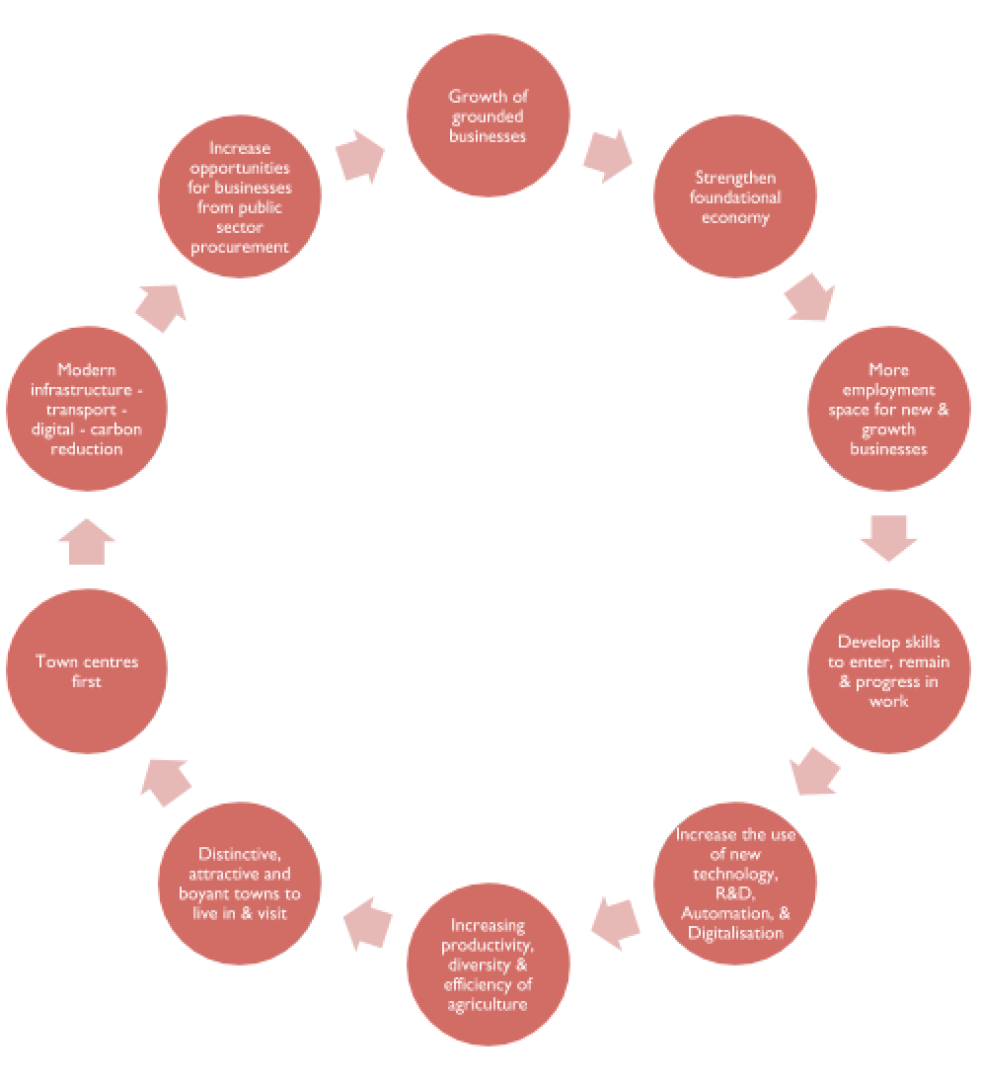
Whitland today
Whitland is a 'working town' and for its size, it supports a large number of businesses and several employment areas. This includes a small traditional town centre and the livestock market and auctions.
The area is in a good location on the road network location halfway between Carmarthen and Haverfordwest on the A40 (the Trans European Network), A477 and the London – Fishguard railway route.
In recent years there has been a modest amount of housing and employment growth with scope for more. However, because of the town's environmental protection and flood risk constraints means the town has limited opportunities to physically grow.
Outside of the town, there exists a broad range of rural enterprises including agricultural, land-based industries, food and drink and tourism. There are many microbusinesses, including 'lifestyle', visitor-related and creative industries combining both living and working in rural areas.
There is also an important foundational side of the economy with many people employed in providing essential day to day local services, skilled trades, and professions such as driving instructors, child and home care etc.
As well as providing the secondary school and railway connections for the for nearby St Clears and Laugharne, Whitland's key role is in providing the social, employment, education and localised retail for the outlying villages across the Llanboidy Ward in Carmarthenshire and Lampeter Velfrey Ward in Pembrokeshire.
Overall, Whitland is a growing town that has experienced a small amount of population and housing growth in recent years. The towns economic growth is also reflected in the higher than average number of people living in the area of working age that are economically active and in fulltime employment.
Whitland is a 'working town' and for its size, it supports a large number of businesses and several employment areas. This includes a small traditional town centre and the livestock market and auctions.
The area is in a good location on the road network location halfway between Carmarthen and Haverfordwest on the A40 (the Trans European Network), A477 and the London – Fishguard railway route.
In recent years there has been a modest amount of housing and employment growth with scope for more. However, because of the town's environmental protection and flood risk constraints means the town has limited opportunities to physically grow.
Outside of the town, there exists a broad range of rural enterprises including agricultural, land-based industries, food and drink and tourism. There are many microbusinesses, including 'lifestyle', visitor-related and creative industries combining both living and working in rural areas.
There is also an important foundational side of the economy with many people employed in providing essential day to day local services, skilled trades, and professions such as driving instructors, child and home care etc.
As well as providing the secondary school and railway connections for the for nearby St Clears and Laugharne, Whitland's key role is in providing the social, employment, education and localised retail for the outlying villages across the Llanboidy Ward in Carmarthenshire and Lampeter Velfrey Ward in Pembrokeshire.
Overall, Whitland is a growing town that has experienced a small amount of population and housing growth in recent years. The towns economic growth is also reflected in the higher than average number of people living in the area of working age that are economically active and in fulltime employment.
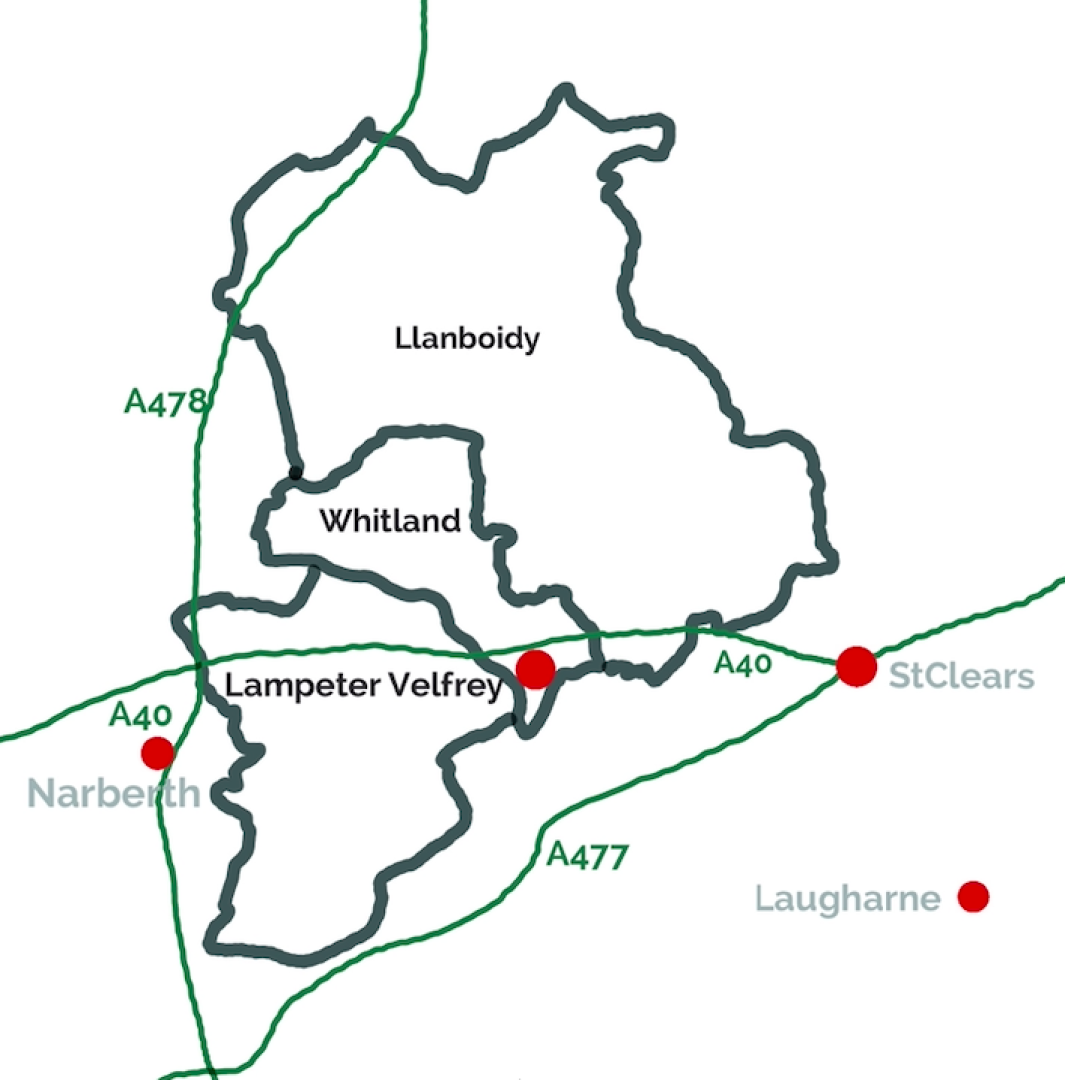
Socio-economic picture
The population of Whitland is 6,100 and this includes the 2,370 living in the built-up area of the town. In comparison with rural Carmarthenshire - within the last ten years - the Whitland area had experienced:
- population growth
- a growing older-aged population
- an increase in the working-age population.
- above-average economic activity and full-time employment
- a relatively successful although lower-skilled local economy.
- higher than average levels of home working and self-employment reflecting agricultural employment, sole-traders and 'lifestyle' and freelance workers.
- a small amount of new housing development has helped keep house prices close to the average
- lack of affordable homes.
- declining use of the Welsh language.
It should also be noted that despite the general appearance of relative prosperity there are still those who are dependent on a part-time, low skilled and low wage income with pockets of local deprivation.
| Rural County | Whitland area | |
| Population | Increase 1.8% | Increase 2.4% |
| Working age | Decline 3% | Increased 2% |
| Gross household income | £28,622 | £28,976 |
| Median house prices | £135k | £133k - £154k |
| Economically active | 66% | 70% |
| Full-time employment | 33% | 36% |
| Work from home | 7% | 11% |
| Self-employed | 14% | 20% |
| Largest occupation | Skilled trades 19% | Skilled trades 24% |
| No skills | 25% | 27% |
| Higher qualifications | 30% | 27% |
| Employed agriculture | 6% | 11% |
Sources: ONS Census & NOMIS - Baseline study
Whitland has a diverse economic base with over 220 business across a diverse range including factory, storage, workshops and offices. Most businesses are either micro and small (less than 50 employees) and across sectors that range from medical, engineering, to agriculture-related industries.
Whitland Engineering is a good example of a grounded local business specialising in food industry engineering and project management with over 50 staff working in design and fabrication.
The largest local business is Magstim, an international business headquartered in Whitland manufacturing advanced medical machinery for export and employing some 100 staff. Whitland Auctions is also key to the economic, employment and community life of the town and supports other businesses such as farm machinery dealers, feed merchants etc (e.g. Riverlea and David Harries).
The largest employment sectors:
- 15% wholesale and retail trade
- 13% human health and social work
- 11% agriculture
The key issues and opportunities for sites and premises include:
- high levels of occupancy and demand for small and medium-sized space
- a limited supply of available starter/small units
- existing stock is mostly old/secondary quality and in need of investment to bring it up to a modern standard
- availability of large distribution and storage premises at the former Whitland Creamery site. available land for future employment development
Town centre
The centre is mostly independent, with a diverse range of key shops and essential services, including the main convenience store (Co-op), newsagent, farm shop and butchers. Comparison (non-food) is equally good with hardware, furniture, gift/craft, baby/toddler and knitting offer. Also, the town centre supports a variety of café, takeaway and public houses together with a range of local services including doctors, dentist, a chemist/pharmacy, hairdressers, laundrette and post office. The centre has:
There is a limited evening economy which is characterised by traditional pub and takeaways. There are also no major leisure and cultural venues.
Before COVID-19, the high occupancy levels and general vibrancy of the centre, together with commuters parking near to the station, meant that car parking was often difficult
The centre is mostly independent, with a diverse range of key shops and essential services, including the main convenience store (Co-op), newsagent, farm shop and butchers. Comparison (non-food) is equally good with hardware, furniture, gift/craft, baby/toddler and knitting offer. Also, the town centre supports a variety of café, takeaway and public houses together with a range of local services including doctors, dentist, a chemist/pharmacy, hairdressers, laundrette and post office. The centre has:
- A growing number of retail businesses
- a falling vacancy rate of 6.5%
- speciality retail
- free town centre Wi-Fi
- +50% of visitors typically stay more than 20 minutes
There is a limited evening economy which is characterised by traditional pub and takeaways. There are also no major leisure and cultural venues.
Before COVID-19, the high occupancy levels and general vibrancy of the centre, together with commuters parking near to the station, meant that car parking was often difficult
Visitor economy
Whitland is not an established visitor destination with the same compelling reason to visit as nearby and better-known Narberth, Pendine and Laugharne.
However, the visitor attractions include the volunteer-run Hywel Dda Centre - historical exhibition and gardens concerning the first Welsh code of law described as one of the wonders of Welsh history. The nearby Whitland Abbey is a low-key ruin and the reputed site of Hywel Dda.
Outside of the town, it is notable that Whitland is at the centre of regional winemaking with two vineyards (Jabajak Vineyard and Velfrey Vineyard) nearby and a third at Hebron Vineyard near Llanglydwen.
Cycling tourism is one of Carmarthenshire's priorities and Whitland features at the start of a published road ride routes connecting with Laugharne and St Clears. However, there are only a few 'Cyclist Welcome' place to stay in the area. Whitland's accommodation base is also relatively small and made up of pubs with rooms and farm-style B&Bs
Annual events - Whitland Week and the Christmas Lights are important locally but low key visitor attractions.
Whitland is not an established visitor destination with the same compelling reason to visit as nearby and better-known Narberth, Pendine and Laugharne.
However, the visitor attractions include the volunteer-run Hywel Dda Centre - historical exhibition and gardens concerning the first Welsh code of law described as one of the wonders of Welsh history. The nearby Whitland Abbey is a low-key ruin and the reputed site of Hywel Dda.
Outside of the town, it is notable that Whitland is at the centre of regional winemaking with two vineyards (Jabajak Vineyard and Velfrey Vineyard) nearby and a third at Hebron Vineyard near Llanglydwen.
Cycling tourism is one of Carmarthenshire's priorities and Whitland features at the start of a published road ride routes connecting with Laugharne and St Clears. However, there are only a few 'Cyclist Welcome' place to stay in the area. Whitland's accommodation base is also relatively small and made up of pubs with rooms and farm-style B&Bs
Annual events - Whitland Week and the Christmas Lights are important locally but low key visitor attractions.
Brand and marketing
We have found that the town doesn't have a clear, up to date, online place that visitors can go to see what the town has on offer from either tourism or local business offering perspective, and instead is reliant on a range of different sites with different messaging or outdated Tripadvisor listings which do not describe the vibrancy of the businesses, the people and the local points of interest that are on offer. Aside from Wikipedia and the Town Councils site, which describes the history, there is a clear lack of a site that describes the town's current offering(s) to use as a guide for their visit.
We have found that the town doesn't have a clear, up to date, online place that visitors can go to see what the town has on offer from either tourism or local business offering perspective, and instead is reliant on a range of different sites with different messaging or outdated Tripadvisor listings which do not describe the vibrancy of the businesses, the people and the local points of interest that are on offer. Aside from Wikipedia and the Town Councils site, which describes the history, there is a clear lack of a site that describes the town's current offering(s) to use as a guide for their visit.
Transport and movement
Accessibility by road and rail is good with the A477 and A40 (the Trans European Network) linking with the Republic of Ireland. The London – Fishguard railway route is a major asset for employment, leisure and visitors to the area and provides hourly services.
However, the town centre experiences issues with car parking areas often being full and is perceived locally as a restriction on the town centres growth. There are also concerns that parking near to the train station and at St Mary's Street are dependent on agreements with private landowners that may not be guaranteed over the longer term.
Travel to work patterns provides a picture of commuter behaviour and understanding of the number of people travelling from the study area to a place of work (shown red) or from another place into the study area for work (shown blue). It shows how the Whitland area is reliant on Carmarthen and other major towns for employment but also how the town also provides employment residents of the wider area.
Accessibility by road and rail is good with the A477 and A40 (the Trans European Network) linking with the Republic of Ireland. The London – Fishguard railway route is a major asset for employment, leisure and visitors to the area and provides hourly services.
However, the town centre experiences issues with car parking areas often being full and is perceived locally as a restriction on the town centres growth. There are also concerns that parking near to the train station and at St Mary's Street are dependent on agreements with private landowners that may not be guaranteed over the longer term.
Travel to work patterns provides a picture of commuter behaviour and understanding of the number of people travelling from the study area to a place of work (shown red) or from another place into the study area for work (shown blue). It shows how the Whitland area is reliant on Carmarthen and other major towns for employment but also how the town also provides employment residents of the wider area.
- The average distance travelled to work was above average (24.3km compared to 22.3km).
- In the wider Whitland hinterland there was an above-average proportion of people working from home 10.9% compared to 6.8%).
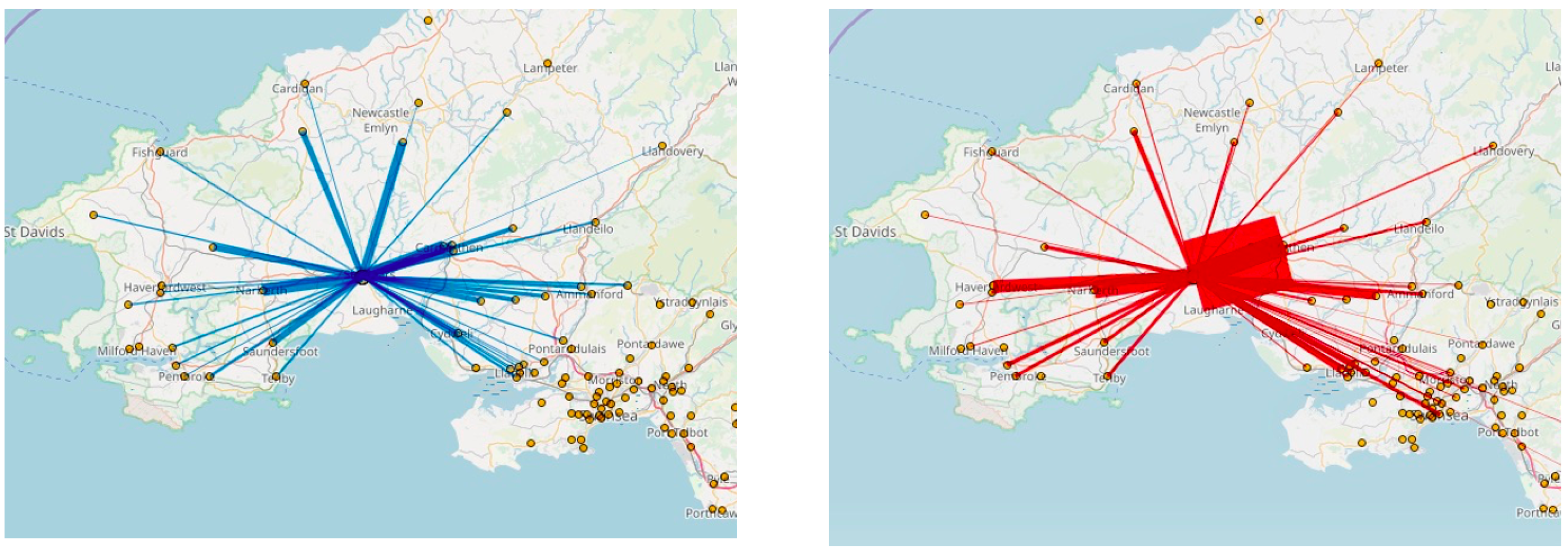
Source: 2011 Census - DataShine: Commute
Broadband and digital connectivity
The central town area appears to have good digital connectivity, although it is clear that there are larger areas (marked in red) in the wider countryside and villages with connection difficulties. There are 705 (50%) out of a total of 1,404 premises in the Whitland postcode area without non-superfast broadband.
An advantage for visitors to Whitland is free Wi-Fi managed by the Town Council is provided and located in the Town Centre covering Livestock Mart, Car Parks, Train Station and Parc Dr Owen.
The central town area appears to have good digital connectivity, although it is clear that there are larger areas (marked in red) in the wider countryside and villages with connection difficulties. There are 705 (50%) out of a total of 1,404 premises in the Whitland postcode area without non-superfast broadband.
An advantage for visitors to Whitland is free Wi-Fi managed by the Town Council is provided and located in the Town Centre covering Livestock Mart, Car Parks, Train Station and Parc Dr Owen.
Planning, development & environment
Due to significant areas of flood risk, the areas of potential development within the town are limited. This curtails the potential to develop outside of designated sites and higher ground. In terms of future growth and development, the Revised Local Development Plan considers Whitland a town for future modest growth given its strategic and accessible location on the A40. This will see a reduced opportunity for the development of allocated residential development and employment in the future. The allocations include:
Proposals for a new General Hospital is arguably a potential 'game-changing' opportunity for Whitland. Hywel Dda Health Board has consulted on plans for a new General Hospital on a site in the area between Narberth and St Clears. The Health Board site selection process includes Whitland.
Regardless of location, the Hospital holds substantial potentially transformational growth of local business in the Whitland area. The timetable for a decision, construction and opening are within the timeframe of this plan.
Due to significant areas of flood risk, the areas of potential development within the town are limited. This curtails the potential to develop outside of designated sites and higher ground. In terms of future growth and development, the Revised Local Development Plan considers Whitland a town for future modest growth given its strategic and accessible location on the A40. This will see a reduced opportunity for the development of allocated residential development and employment in the future. The allocations include:
- 56 new homes including 11 affordable
- 1.97ha for new employment development
Proposals for a new General Hospital is arguably a potential 'game-changing' opportunity for Whitland. Hywel Dda Health Board has consulted on plans for a new General Hospital on a site in the area between Narberth and St Clears. The Health Board site selection process includes Whitland.
Regardless of location, the Hospital holds substantial potentially transformational growth of local business in the Whitland area. The timetable for a decision, construction and opening are within the timeframe of this plan.
